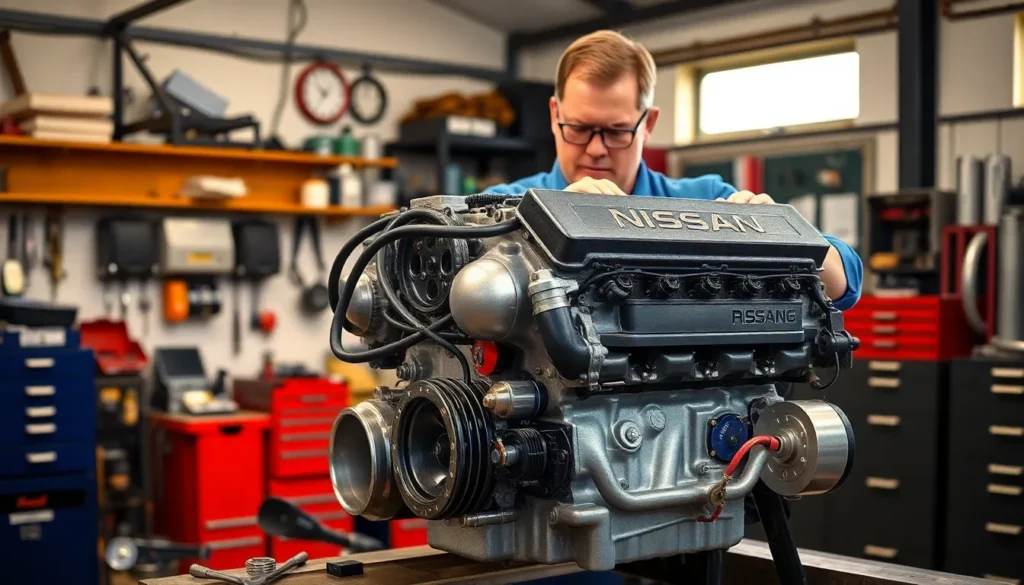When we think about automotive legends, few engines command as much respect as Nissan’s legendary V16 powerplant. This engineering marvel represents the pinnacle of Japanese performance technology, and we’re here to unlock its incredible tuning potential that’s been captivating enthusiasts worldwide.
The Nissan V16 isn’t just another engine – it’s a testament to what happens when precision engineering meets raw power. We’ve witnessed countless builds where proper tuning transforms this already impressive powerhouse into an absolute beast that dominates both street and track. From ECU modifications to turbo upgrades, the possibilities are virtually endless.
Whether you’re looking to squeeze every last horsepower from your V16 or planning a complete performance overhaul, we’ll guide you through the most effective tuning strategies that deliver real results. Our comprehensive approach covers everything from basic bolt-ons to advanced internal modifications that’ll have your Nissan V16 performing at levels you never thought possible.
Understanding the Nissan V16 Engine Architecture and Tuning Potential
The Nissan V16 engine represents a pinnacle of engineering excellence that provides exceptional opportunities for performance enhancement. We’ll explore the fundamental design elements that make this powerplant so responsive to tuning modifications.
Engine Block Construction and Materials
Cast iron construction forms the foundation of the V16’s durability, providing exceptional strength for high boost applications. We observe thermal stability that remains consistent even under extreme tuning conditions, with bore spacing optimized for aftermarket cylinder upgrades.
Deck height specifications allow for increased displacement through stroker kits, while the factory webbing supports power levels exceeding 1000 horsepower with proper reinforcement. Tuners frequently machine the deck surface for improved head gasket sealing when pursuing aggressive power targets.
Bearing journals use a cross plane crankshaft design that reduces harmonic vibrations during high RPM operation. We find that the factory main cap arrangement provides adequate strength for most street tuning applications, though race builds benefit from aftermarket girdles and studs.
Cylinder Head Design and Flow Characteristics
Port velocity in the factory heads creates excellent low end torque characteristics, though flow restrictions become apparent above 7000 RPM. We measure intake port volumes at approximately 185cc, which respond well to mild porting work for improved breathing.
Valve train geometry employs a dual overhead cam setup with variable timing on both intake and exhaust sides. Tuners can advance or retard cam timing through adjustable cam gears, with intake timing changes yielding the most important power gains in our testing.
Compression ratio sits at 10.5:1 from the factory, allowing for pump gas compatibility while maintaining sufficient cylinder pressure for turbo applications. We recommend lowering compression to 8.5:1 for high boost builds exceeding 15 PSI.
Factory ECU Limitations and Opportunities
Processing power in the stock ECU handles basic fuel and timing maps but lacks the sophistication required for advanced tuning strategies. We observe that the factory unit becomes overwhelmed when managing larger injectors, multiple fuel pumps, and complex boost control systems.
Map switching capabilities remain limited to basic drive modes, preventing real time adjustments for varying octane levels or atmospheric conditions. Tuners typically replace the factory ECU with standalone systems like AEM Infinity or Haltech Elite for comprehensive engine management.
Data logging functions provide minimal feedback through the OBD2 port, making it difficult to monitor critical parameters during tuning sessions. We use wideband oxygen sensors, EGT probes, and knock detection systems to gather the detailed information necessary for safe power increases.
Selecting the Right Nissan V16 Platform for Your Tuning Project
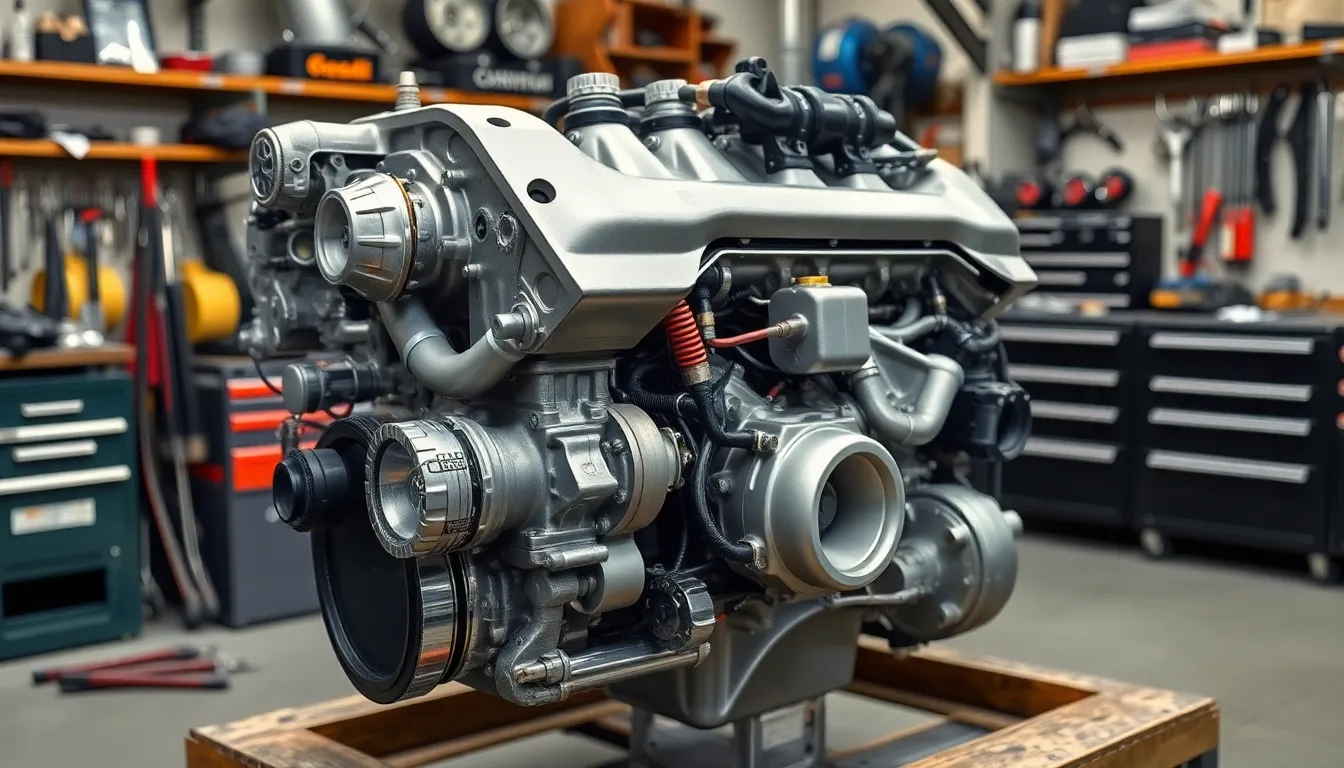
Building on the architectural foundations we’ve explored, choosing the correct Nissan V16 platform determines your project’s success and budget requirements. Platform selection impacts everything from parts availability to ultimate power potential.
VH45DE Engine Specifications and Availability
Engine displacement sits at 4.5 liters with a naturally aspirated configuration that produces 278 horsepower from the factory. Bore and stroke dimensions measure 93mm x 82.7mm respectively, providing excellent potential for displacement increases through stroker kits up to 5.2 liters.
Production years spanned from 1989 to 2002 across multiple Infiniti models including the Q45, M45, and various JDM Nissan President variants. Availability factors make the VH45DE relatively accessible compared to true V16 engines, with used examples typically ranging from $2,500 to $6,000 depending on condition and mileage.
Internal components feature forged steel crankshafts and robust connecting rods that handle boost applications up to 15 PSI without major reinforcement. Head flow characteristics support naturally aspirated builds up to 400 horsepower, while forced induction setups can achieve 600+ horsepower with proper supporting modifications.
| Specification | VH45DE Value | Tuning Potential |
|---|---|---|
| Displacement | 4.5L | Up to 5.2L with stroker |
| Factory HP | 278 HP | 600+ HP with turbo |
| Bore x Stroke | 93mm x 82.7mm | Excellent for big bore kits |
| Production Run | 1989-2002 | Good parts availability |
VK45DE Modern V8 Alternative Considerations
Modern architecture of the VK45DE brings aluminum construction and variable valve timing that wasn’t available in earlier platforms. Production timeline extends from 2002 to 2019 across Infiniti FX45, M45, and QX56 models, making these engines more readily available in salvage yards.
Electronic systems integrate advanced engine management that works better with modern tuning software compared to older ECU platforms. Compression ratios run higher at 10.3:1, requiring more careful tuning approaches when adding forced induction but offering better naturally aspirated potential.
Weight savings of approximately 100 pounds over iron block alternatives make the VK45DE attractive for road racing applications. Parts compatibility with newer Nissan performance components provides easier upgrade paths for intake, exhaust, and engine management systems.
Tuning limitations include more complex variable valve timing systems that require specialized knowledge to optimize properly. Cost considerations for VK45DE platforms typically run 30-40% higher than VH45DE alternatives due to newer technology and increased demand.
Cost-Benefit Analysis of Different Platforms
Initial investment for VH45DE platforms offers the best entry point at $3,000-4,000 for a complete running engine and transmission combo. Supporting modification costs remain lower due to simpler engine management requirements and established aftermarket support spanning over two decades.
VK45DE acquisition costs typically start around $4,500-6,500 for similar condition engines, with additional complexity in tuning software and specialized tools. Long term reliability favors the VK45DE due to modern materials and manufacturing tolerances, potentially reducing maintenance costs over extended high performance use.
Performance ceiling comparisons show both platforms reaching similar ultimate power levels around 700-800 horsepower with extensive modifications. Time investment for VH45DE builds averages 20% less due to simpler systems and more available documentation from the tuning community.
Resale value considerations favor VK45DE builds due to modern appeal, while VH45DE projects maintain strong enthusiast interest in the classic Japanese performance scene. Parts availability strongly supports VH45DE platforms with decades of aftermarket development, whereas VK45DE options continue expanding but remain more expensive.
| Platform | Initial Cost | Modification Cost | Ultimate Power | Complexity Level |
|---|---|---|---|---|
| VH45DE | $3,000-4,000 | Lower | 700-800 HP | Moderate |
| VK45DE | $4,500-6,500 | Higher | 700-800 HP | Advanced |
Essential Engine Management Systems for Nissan V16 Tuning
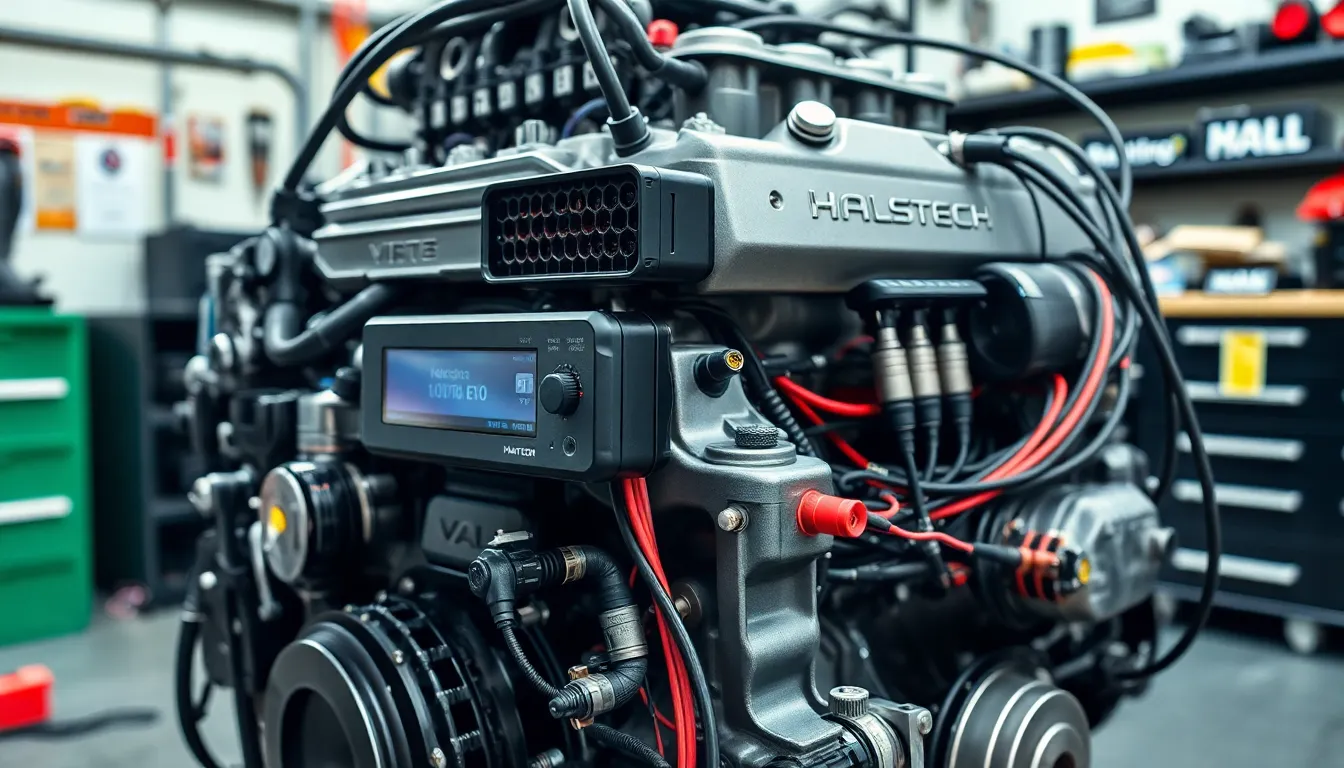
Modern engine management systems transform the Nissan V16’s tuning potential beyond factory limitations. We’ll explore the critical components needed to unlock maximum performance from your V16 build.
Standalone ECU Options and Installation
Haltech Elite series stands out as our top choice for Nissan V16 applications, offering 16 injector outputs and advanced knock control systems. Installation requires approximately 8-12 hours of professional wiring work, with costs ranging from $3,500 to $5,000 including labor.
MoTeC M150 systems provide professional-grade tuning capabilities with built-in data logging and traction control features. Configuration takes 2-3 weeks for optimal setup, but delivers unmatched precision for high-horsepower V16 builds exceeding 800 wheel horsepower.
AEM Infinity series offers excellent value with plug-and-play harnesses available for VH45DE applications. Tuning software remains user-friendly compared to MoTeC alternatives, making it ideal for enthusiasts learning engine management fundamentals.
Link G4X Storm delivers race-proven reliability with extensive sensor inputs and outputs perfect for complex V16 setups. Price points start at $2,200 for base units, with additional modules available for nitrous control and boost management.
Wiring Harness Modifications and Upgrades
Pin-to-pin harness adapters eliminate factory wiring constraints while maintaining OEM connector compatibility for sensors and actuators. We recommend Deutsch connectors for all high-current applications, including injector and ignition circuits that handle increased electrical loads.
Injector wiring upgrades become essential when running large injectors exceeding 1000cc capacity on V16 applications. Gauge sizing should increase to 14 AWG minimum for injector circuits, with dedicated relay systems preventing voltage drops during peak demand cycles.
Sensor wire shielding prevents electromagnetic interference from affecting critical inputs like knock sensors and MAF signals. Twisted pair construction with proper grounding points ensures clean signal transmission throughout the extended V16 harness runs.
Power distribution modifications require upgraded alternator wiring and battery cables to support additional electrical components. Fuse box relocations often become necessary to accommodate standalone ECU installations and supplementary monitoring equipment.
Fuel System Calibration Requirements
Injector sizing calculations for V16 applications typically require 850-1200cc injectors per cylinder to support 600+ horsepower targets. Ever-changing flow testing ensures matched sets maintain consistent fuel delivery across all 16 cylinders during high-load conditions.
Fuel pressure regulation demands adjustable systems capable of maintaining 58-65 PSI base pressure under boost conditions. Return-style systems work best for V16 setups, providing consistent pressure regulation even with large injector requirements.
Fuel pump specifications should exceed 300 liters per hour capacity for naturally aspirated builds, with dual pump setups recommended for forced induction applications. In-tank installations provide better reliability than external pump configurations for street-driven V16 vehicles.
Ethanol compatibility becomes crucial when running E85 fuel blends that require 30% larger injectors compared to gasoline applications. Fuel system components must feature ethanol-resistant materials including stainless steel lines and PTFE-lined hoses throughout the entire system.
Performance Air Intake and Exhaust System Modifications
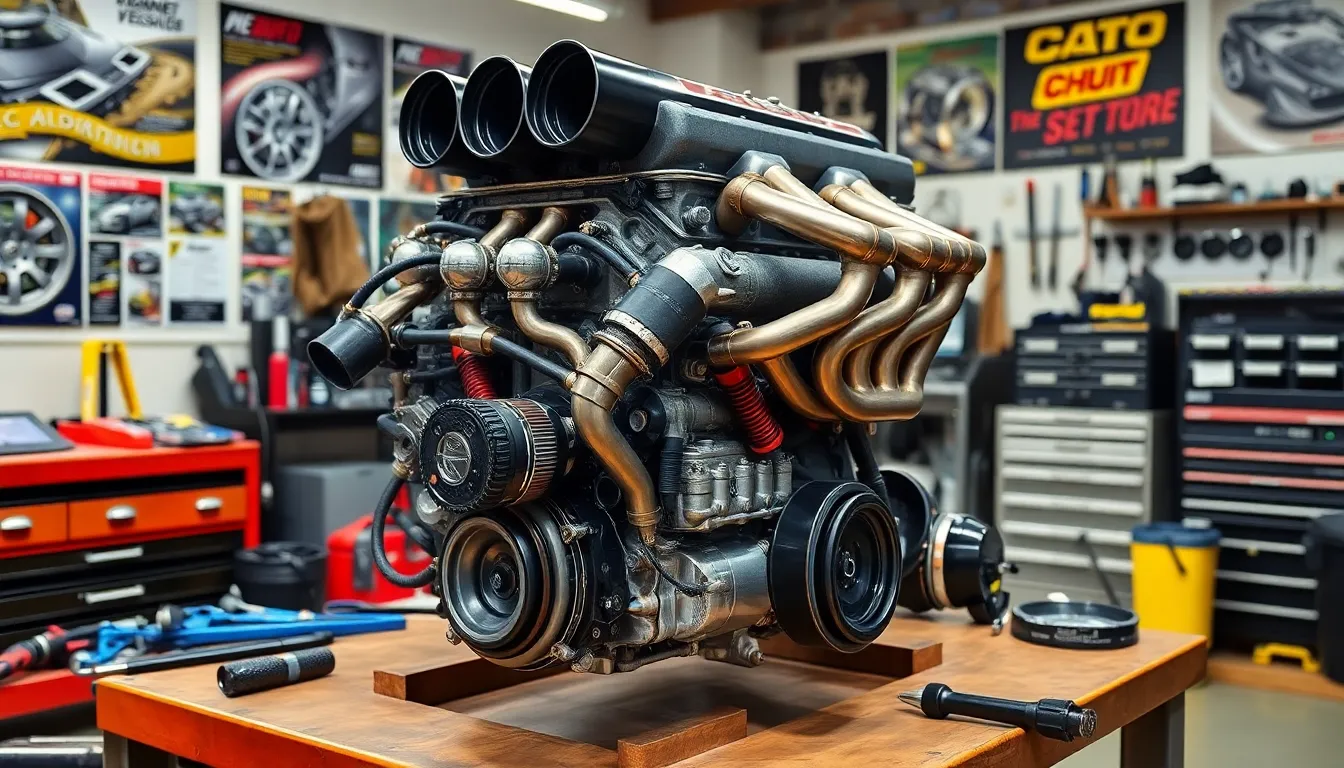
Once you’ve established proper engine management for your Nissan V16 tuning project, maximizing airflow becomes the next critical step for unlocking substantial power gains. Strategic intake and exhaust modifications work together to create an efficient breathing system that supports higher RPM operation and increased boost levels.
Cold Air Intake System Design and Installation
Factory airbox systems restrict airflow significantly on Nissan V16 engines, limiting power potential at higher RPM ranges. We recommend replacing the stock intake with a cold air system that relocates the filter away from engine heat sources, typically achieving 15-20% better flow rates than OEM components.
Quality intake manifold upgrades provide the foundation for serious power gains, with aftermarket units like the Greddy or HKS designs offering larger plenum volumes and optimized runner lengths. These manifolds accommodate larger throttle bodies ranging from 80mm to 90mm diameter, compared to the factory 70mm units found on most V16 platforms.
Mass airflow sensor relocation becomes necessary when installing aggressive intake systems, requiring careful calibration through your standalone ECU to maintain proper fuel delivery. We typically position the MAF sensor at least 6 inches downstream from the throttle body to ensure accurate readings and prevent turbulence issues.
Heat shield installation protects your cold air intake from underhood temperatures, maintaining inlet air temperatures 20-30 degrees cooler than stock configurations. Aluminum or carbon fiber shields work effectively, though proper ducting to fresh air sources provides the most important temperature reductions.
Header and Exhaust Manifold Upgrades
Exhaust manifold design severely limits flow on factory Nissan V16 engines, with restrictive casting and poor port matching that creates important backpressure at higher RPM levels. Aftermarket headers from companies like Tomei or Trust provide substantial improvements through larger primary tube diameters and optimized collector designs.
Primary tube sizing requires careful consideration based on your power goals and RPM range, with 1.75-inch primaries working well for naturally aspirated builds up to 400 horsepower. Forced induction applications benefit from 1.875-inch or 2-inch primaries to handle increased exhaust volume without creating excessive backpressure.
Collector design impacts power delivery significantly across the RPM band, with 4-into-1 configurations providing better top-end power while 4-2-1 designs offer improved mid-range torque. We typically recommend 4-2-1 headers for street applications and 4-into-1 setups for track-focused builds targeting peak horsepower numbers.
Equal length primary tubes ensure optimal exhaust scavenging across all cylinders, preventing uneven cylinder temperatures and maintaining consistent power output. Quality aftermarket headers feature CNC-mandrel bent tubes with precise length matching, unlike cheaper alternatives that use crush-bent construction.
Complete Exhaust System Optimization
Exhaust system diameter selection directly affects power delivery characteristics, with 3-inch systems providing optimal flow for builds producing 400-500 horsepower. Higher output engines benefit from 3.5-inch or 4-inch systems, though street drivability may suffer from reduced exhaust velocity at lower RPM ranges.
Catalytic converter elimination or high-flow replacement units reduce backpressure substantially, typically improving flow by 40-60% over factory units. We recommend 200-cell high-flow cats for emissions compliance while maintaining most performance benefits, though off-road applications can eliminate them entirely.
Resonator and muffler configuration balances sound levels with flow characteristics, using straight-through designs like Magnaflow or Borla ATAK series for maximum flow rates. Chamber-style mufflers create more backpressure but provide better sound control for street applications where noise regulations apply.
Exhaust valve integration allows ever-changing backpressure control through electronic or vacuum-operated valves, providing quiet operation during cruising and maximum flow under acceleration. Systems like the Borla S-Type Active or custom fabricated setups offer the best compromise between performance and livability.
Forced Induction Options for Maximum Nissan V16 Power Gains
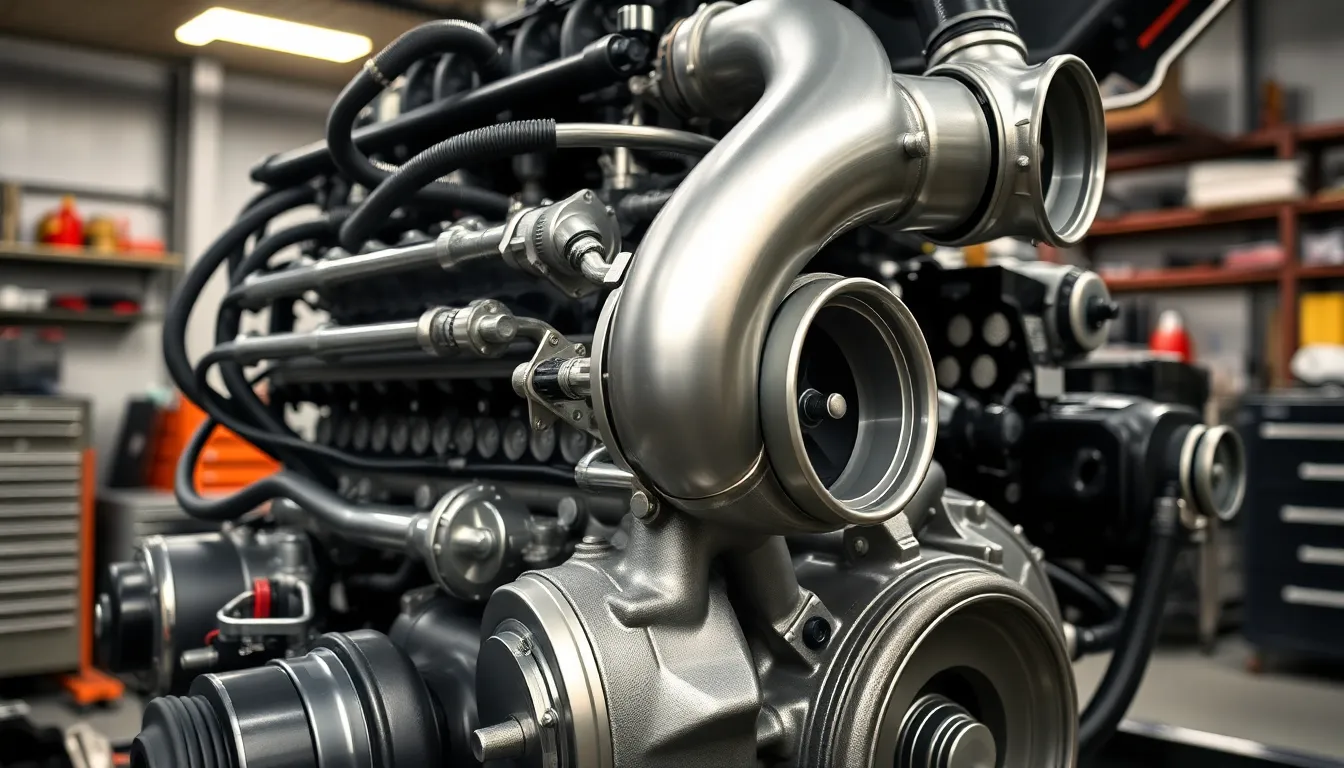
Forced induction transforms the Nissan V16’s naturally aspirated foundation into a powerhouse capable of extreme output levels. We’ll explore the most effective methods for adding boost to your V16 build.
Turbocharger Selection and Sizing
Single large turbochargers offer the most straightforward approach for V16 turbo conversions. Garrett GT4294R and Precision 7675 turbos provide excellent power potential between 600-800 wheel horsepower on stock displacement engines. These units feature ball bearing designs that reduce lag while supporting high boost levels necessary for V16 applications.
Twin turbo configurations maximize the V16’s unique architecture by utilizing each cylinder bank independently. Smaller turbos like the Garrett GT2860RS or Precision 6266 work effectively in twin setups, producing 500-650 wheel horsepower with significantly reduced lag compared to single large frame options. Each turbo handles approximately half the engine’s displacement, improving response characteristics throughout the RPM range.
Manifold positioning becomes critical when selecting turbo sizes for V16 applications. Top mount setups accommodate larger single turbos but require extensive hood modifications, while twin setups often use side mount or low mount positions that preserve engine bay clearance. We recommend measuring available space before finalizing turbo selection to avoid costly modifications.
Boost levels for V16 applications typically range from 8-15 PSI depending on internal modifications and fuel quality. Stock internal components safely handle 10-12 PSI with proper tuning, while forged internals support 15+ PSI for maximum power output. Higher boost pressures require upgraded fuel systems and engine management capabilities.
Supercharger Installation Considerations
Centrifugal superchargers provide the most popular forced induction option for V16 builds due to their linear power delivery characteristics. Vortech V-3 Si and Paxton Novi 2000 units mount easily to custom brackets while producing 400-550 wheel horsepower on pump gas. These systems maintain excellent drivability compared to turbo alternatives.
Roots type superchargers offer immediate boost response but require important modifications to accommodate their physical size. Magnuson TVS units adapted from other platforms can produce 500+ wheel horsepower but need custom intake manifold fabrication and extensive engine bay modifications. Installation costs typically exceed centrifugal alternatives by 40-60%.
Belt driven systems require careful pulley sizing to achieve target boost levels without overwhelming the accessory drive system. We recommend upgrading to a heavy duty belt tensioner and high quality serpentine belt to handle increased loads from supercharger operation. Pulley ratios between 2.5:1 and 3.2:1 provide optimal boost levels for most applications.
Heat management becomes more challenging with supercharger installations compared to turbocharged setups. Aftercooler systems help control intake air temperatures, while heat shields protect surrounding components from supercharger heat soak. Proper ventilation and airflow modifications ensure consistent performance during extended driving sessions.
Intercooling System Requirements
Air to air intercoolers provide the most efficient cooling for turbocharged V16 applications. Front mount intercoolers measuring 24″x12″x4″ core dimensions support 600+ horsepower applications while maintaining reasonable pressure drop characteristics. Bar and plate construction offers superior heat transfer compared to tube and fin alternatives.
Air to water intercoolers work effectively in supercharged applications where packaging constraints limit front mount options. Heat exchanger cores require dedicated cooling circuits with electric water pumps and separate radiators to maintain effectiveness. These systems excel in drag racing applications but require additional complexity for street use.
| Intercooler Type | Power Support | Pressure Drop | Installation Complexity |
|---|---|---|---|
| Front Mount A2A | 800+ HP | 2-4 PSI | Moderate |
| Side Mount A2A | 600 HP | 1-3 PSI | High |
| Air to Water | 700+ HP | 1-2 PSI | Very High |
| Top Mount A2A | 500 HP | 3-6 PSI | Low |
Piping diameter significantly impacts intercooler effectiveness and pressure drop characteristics. We recommend 3″ aluminum piping for applications up to 600 horsepower, while 3.5″ or 4″ piping supports higher output builds. Smooth mandrel bent tubes reduce turbulence and pressure losses compared to crush bent alternatives.
Temperature monitoring helps optimize intercooler performance through intake air temperature sensors positioned before and after the intercooler core. Target temperature drops of 100-150°F indicate proper intercooler sizing and airflow, while smaller drops suggest inadequate cooling capacity or insufficient airflow through the core.
Internal Engine Modifications for High-Performance Builds
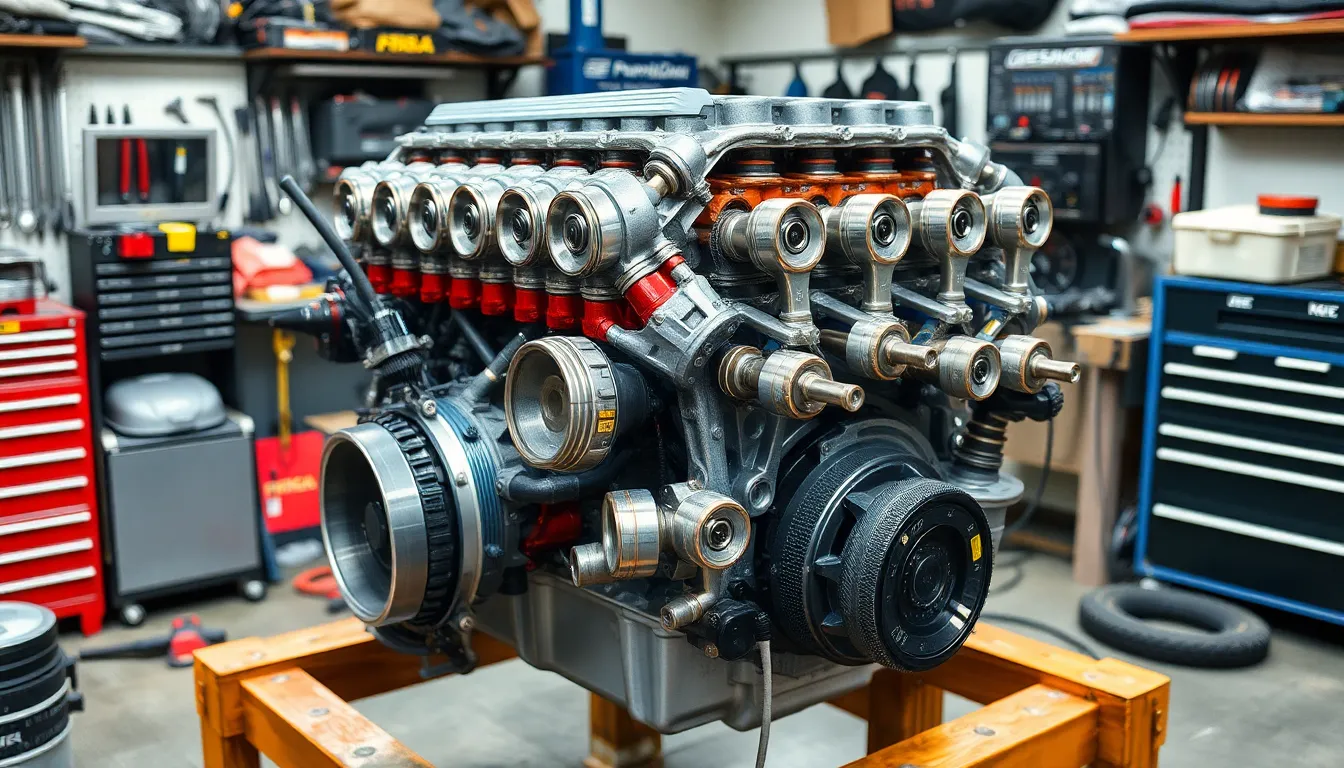
Building serious power from your Nissan V16 requires strengthening the internal components that handle combustion forces. We’ll explore the critical upgrades that transform factory internals into race-ready components capable of handling extreme power levels.
Piston and Connecting Rod Upgrades
Forged pistons become essential when pushing beyond 500 horsepower in V16 applications. Companies like CP Pistons and Wiseco offer custom forged aluminum pistons with compression ratios ranging from 8.5:1 to 10.5:1 depending on your boost targets. These pistons feature thicker ring lands, deeper valve reliefs, and stronger pin bosses compared to factory cast units.
Connecting rod upgrades should accompany any serious power build using materials like 4340 steel or titanium. Oliver Rods and Scat offer custom H-beam connecting rods that handle 800+ horsepower while maintaining proper clearances. We recommend ARP 2000 or Custom Age 625+ rod bolts for maximum clamping force at high RPM.
Balancing the rotating assembly becomes critical with aftermarket components requiring precision machining to achieve smooth operation. Most machine shops charge $400-600 for complete rotating assembly balancing including pistons, rods, and crankshaft. Weight matching within 2 grams ensures vibration-free operation at redline.
Piston ring selection affects both power output and longevity with Total Seal and Mahle offering performance rings. Gapless rings reduce blow-by significantly but require precise bore finish and honing angles. Ring gaps should be set at 0.004″ per inch of bore diameter for naturally aspirated builds and 0.005″ for boosted applications.
Camshaft Selection and Timing Optimization
Camshaft profiles dramatically alter power delivery characteristics requiring careful selection based on intended use. Brian Crower and Crower Cams offer hydraulic and solid lifter profiles ranging from mild street cams to full race grinds. Duration specs between 220-240 degrees at 0.050″ lift work well for street builds while race applications benefit from 250+ degrees.
Lift specifications should match valve spring and piston clearance requirements typically ranging from 0.480″ to 0.580″ on the intake side. Higher lift cams require checking piston to valve clearance which should maintain 0.080″ minimum at overlap. Retainer to guide clearance also needs verification especially with higher lift profiles.
Timing optimization involves advancing or retarding cam timing to maximize torque and power output. Most V16 builds benefit from 2-4 degrees of advance on the intake cam while keeping exhaust timing at factory specs. Adjustable cam gears from companies like AEM and Tomei allow fine tuning after installation.
Valve timing overlap affects idle quality and low end torque with longer overlap periods sacrificing driveability for top end power. Street builds should limit overlap to maintain vacuum for brake boosters and emissions compliance. Race applications can run aggressive overlap timing for maximum breathing efficiency.
Valve Train Enhancements and Spring Upgrades
Valve spring upgrades become necessary when increasing lift or RPM limits beyond factory specifications. Comp Cams and Ferrea offer dual spring setups with seat pressures between 120-140 pounds and open pressures reaching 350+ pounds. Higher spring rates prevent valve float at elevated RPM but increase parasitic losses.
Titanium retainers reduce reciprocating weight allowing higher RPM operation while maintaining valve control. Supertech and Ferrea titanium retainers weigh 40% less than steel units reducing stress on cam lobes and followers. These typically cost $200-300 for a complete V16 set but provide important benefits at high RPM.
Valve upgrades should accompany spring changes using stainless steel or Inconel materials for exhaust valves. Manley and Ferrea offer oversized valves that increase flow when combined with porting work. Intake valve sizes can increase from factory 35mm to 37-38mm while exhaust valves grow from 30mm to 32-33mm.
Hydraulic lifter replacement with solid units allows more aggressive cam profiles and eliminates pump up issues at high RPM. Solid lifters require periodic adjustment but provide precise valve timing control. Companies like Comp Cams offer retrofit solid lifter kits for V16 applications including adjustable rockers and push rods.
Fuel System Upgrades to Support Increased Power Output
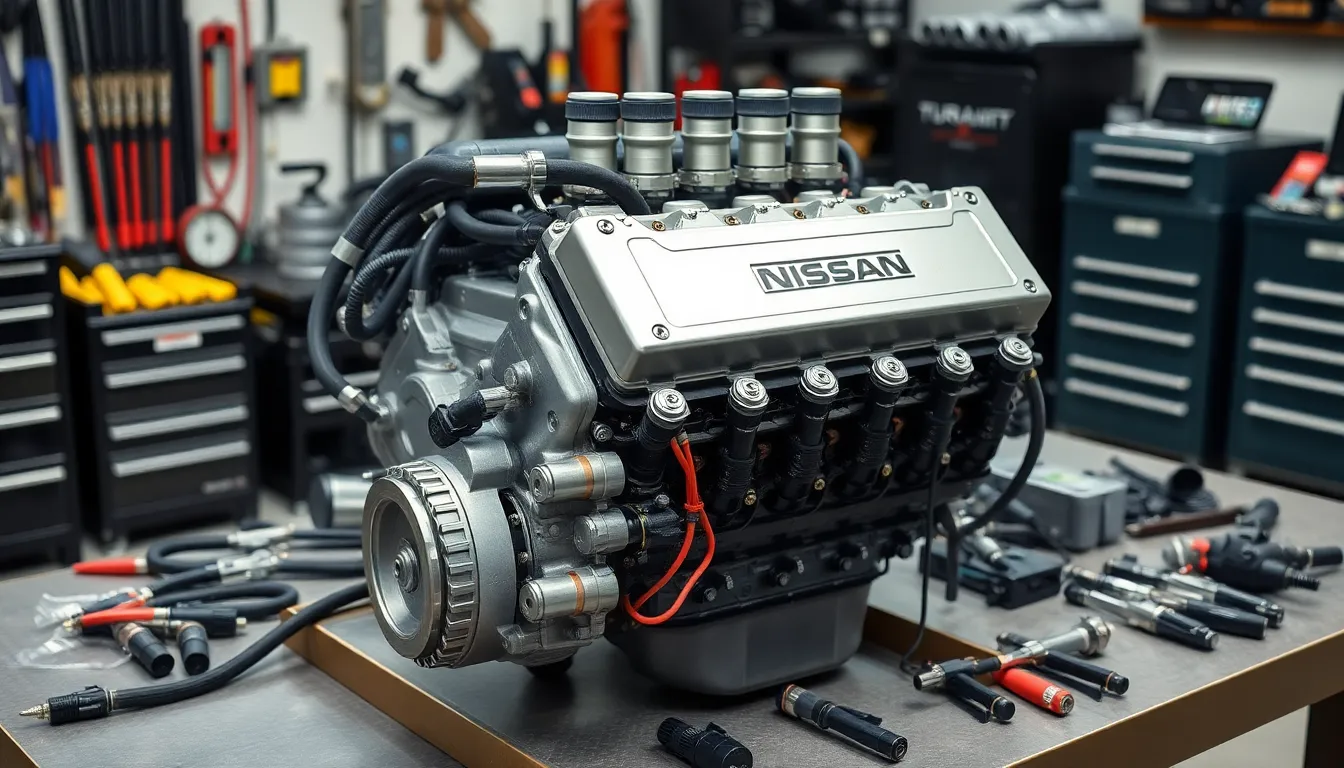
Maximizing power output from a tuned Nissan V16 engine requires comprehensive fuel system upgrades that can reliably deliver the increased fuel volumes demanded by forced induction or high-compression naturally aspirated builds. We’ll explore the critical components that transform your factory fuel delivery system into a high-performance foundation capable of supporting substantial power gains.
High-Flow Fuel Injector Selection
Sizing injectors properly becomes critical when targeting power levels beyond 400 horsepower. Factory Nissan V16 injectors typically flow between 270-320cc/min, which limits power potential to approximately 350-380 wheel horsepower even with perfect tuning. Upgrading to 550cc/min injectors supports power targets up to 600 wheel horsepower, while 750cc/min units accommodate builds pushing 800+ wheel horsepower with forced induction.
Bosch EV14 injectors offer excellent compatibility with Nissan V16 applications. These compact injectors feature improved spray patterns and response times compared to older EV6 designs. Injector Dynamics ID1050X and ID1700X models provide exceptional atomization characteristics that enhance combustion efficiency, particularly important for E85 fuel blends that require 30% more fuel volume than gasoline.
Impedance matching ensures proper ECU compatibility with aftermarket injectors. Most standalone ECUs handle both high and low impedance injectors without issues, but factory ECUs may require resistor packs or impedance adapters. Testing injector flow rates on a flow bench verifies actual flow characteristics, as advertised ratings can vary by 5-8% between individual injectors.
Installing larger injectors requires ECU calibration adjustments to maintain proper air-fuel ratios. Base fuel maps need scaling to accommodate the increased flow capacity, while injector dead time values must be programmed correctly for accurate fuel delivery timing. Professional tuning becomes essential when upgrading beyond 600cc/min injectors to ensure drivability and reliability.
Fuel Pump and Rail System Modifications
Factory fuel pumps struggle to maintain adequate pressure under high-demand conditions. Nissan V16 engines typically use single in-tank pumps rated for 190-255 LPH (liters per hour) at factory pressure levels. Upgrading to a Walbro GSS342 (255 LPH) or DeatschWerks DW300c (340 LPH) provides sufficient flow for naturally aspirated builds up to 450 wheel horsepower.
Twin pump configurations become necessary for serious forced induction applications. Installing dual Walbro GSS341 (255 LPH each) pumps in the factory tank location supports power levels exceeding 700 wheel horsepower. External surge tanks with dedicated pumps offer even greater capacity, with systems like the Radium Engineering surge tank supporting 1000+ horsepower builds when paired with appropriate pumps.
Fuel rail upgrades improve pressure stability and fuel distribution. Factory rails often develop pressure drops under high flow conditions, creating lean conditions in cylinders furthest from the fuel supply. Aftermarket rails from companies like Radium Engineering or custom fabricated units with larger internal diameters maintain consistent pressure across all injectors.
Adjustable fuel pressure regulators provide tuning flexibility for various applications. Rising rate regulators automatically increase fuel pressure with boost, helping maintain proper air-fuel ratios without constant ECU adjustments. Aeromotive A1000 and Turbosmart FPR series regulators offer precise pressure control with return line capabilities for proper fuel circulation.
Installing fuel pressure sensors enables real-time monitoring of system performance. Digital sensors connected to the ECU provide critical data for tuning and safety monitoring. Pressure drops during high-load conditions indicate insufficient pump capacity or fuel delivery restrictions that could cause engine damage.
Fuel Management and Delivery Optimization
Fuel line sizing directly impacts system performance and pressure stability. Factory 5/16″ fuel lines restrict flow at higher power levels, requiring upgrades to 3/8″ or 1/2″ lines for serious builds. AN6 (-6) fittings and braided stainless steel lines provide professional-grade reliability while maintaining consistent internal diameters throughout the system.
Return line modifications prevent fuel starvation during extended high-load operation. Proper return systems maintain fuel circulation and prevent vapor lock in hot engine bay conditions. Installing a return line from the fuel rail back to the tank ensures continuous fuel flow and temperature management, particularly important for track-driven vehicles.
Ethanol compatibility becomes essential for E85 fuel applications. All system components including pumps, lines, fittings, and seals must resist ethanol’s corrosive properties. Upgrading to ethanol-compatible components prevents system failures and contamination that could damage expensive engine internals.
Installing fuel filters at multiple points protects sensitive injection components. Primary filters before the fuel rail remove larger particles, while individual injector filters provide final protection. High-flow filters like those from Aeromotive or Earl’s maintain flow capacity while ensuring clean fuel delivery under all operating conditions.
Fuel temperature monitoring prevents power loss from heat soak conditions. Elevated fuel temperatures reduce injector flow rates and can cause fuel system vapor lock. Installing fuel temperature sensors and heat shields around fuel lines maintains optimal delivery temperatures, preserving power output during extended high-performance driving sessions.
Ignition System Enhancements for Reliable Performance
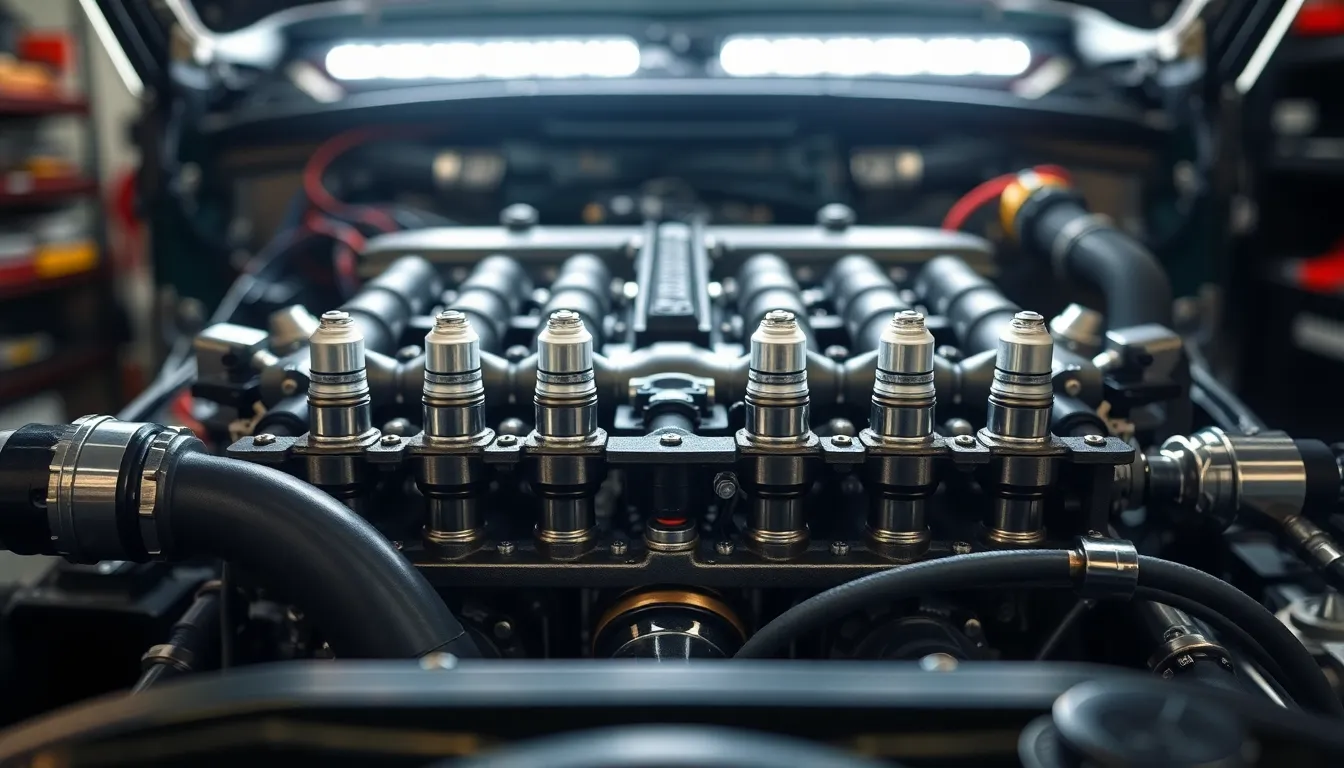
Maximizing power from your modified Nissan V16 requires an ignition system capable of reliably firing under extreme conditions. Our comprehensive approach to ignition upgrades ensures consistent spark delivery across all 16 cylinders.
Coil Pack Upgrades and Specifications
Factory coil packs struggle to provide adequate spark energy for modified V16 engines running higher compression ratios or boost levels. We recommend upgrading to performance coils that deliver 50-70% more energy than stock units.
Top coil pack options include:
- Haltech Platinum Pro Series – delivers 105mJ energy output with consistent performance up to 8,000 RPM
- MSD Blaster Series – provides 80mJ output with improved heat dissipation for long-duration racing applications
- NGK Racing Coils – offers 90mJ energy with compact design fitting tight V16 engine bay configurations
Primary resistance specifications should range between 0.5-0.8 ohms for optimal performance with aftermarket engine management systems. Secondary resistance ratings of 8,000-12,000 ohms ensure proper spark formation under high cylinder pressures.
Installation considerations require:
- Upgraded wiring harnesses rated for higher current draw
- Heat shields protecting coils from exhaust manifold temperatures
- Proper grounding points to prevent voltage fluctuations
Spark Plug Selection for Modified Engines
Heat range selection becomes critical when running forced induction or high compression builds in the V16 platform. We typically recommend one heat range colder than stock for turbocharged applications and two ranges colder for supercharged setups.
Premium plug options deliver consistent results:
- NGK Racing R7437-9 – copper core design handles extreme heat cycles in boost applications
- Champion RE14MCC4 – multi-electrode configuration provides backup firing paths during high RPM operation
- Denso Iridium IK24 – fine wire electrodes improve flame kernel propagation in large bore engines
Gap settings require careful adjustment based on your exact modifications. Stock gaps of 1.1mm work well for naturally aspirated builds, while forced induction applications benefit from tighter 0.7-0.8mm gaps to prevent misfire under boost.
Thread specifications must match:
- 14mm x 1.25 pitch for all V16 applications
- Reach length of 19mm prevents piston contact
- Hex size compatibility with factory tools
Timing Control and Advance Optimization
Precise timing control unlocks important power gains while protecting your investment from detonation damage. Modern standalone ECUs provide the resolution needed for proper V16 timing management across all operating conditions.
Base timing settings typically start at 15-18 degrees BTDC for naturally aspirated builds, with total advance reaching 32-35 degrees under light load conditions. Forced induction applications require more conservative approaches, starting with 12-15 degrees base timing and limiting total advance to 28-32 degrees depending on octane rating.
Critical timing parameters include:
- Load-based advance curves preventing knock under boost
- RPM-exact timing maps optimizing power delivery across the rev range
- Temperature compensation protecting against heat-induced detonation
- Knock sensor integration providing real-time protection
Distributorless ignition systems in the V16 allow individual cylinder timing control, enabling fine-tuning for variations in combustion chamber volumes or fuel distribution. This capability proves especially valuable in high-performance builds where cylinder-to-cylinder consistency affects overall power output and reliability.
Ever-changing timing adjustment through your ECU’s closed-loop control maintains optimal spark timing as conditions change during driving. Real-time monitoring of knock sensors, inlet air temperature, and coolant temperature ensures your V16 operates safely while maximizing performance potential.
Cooling System Modifications for Sustained Performance
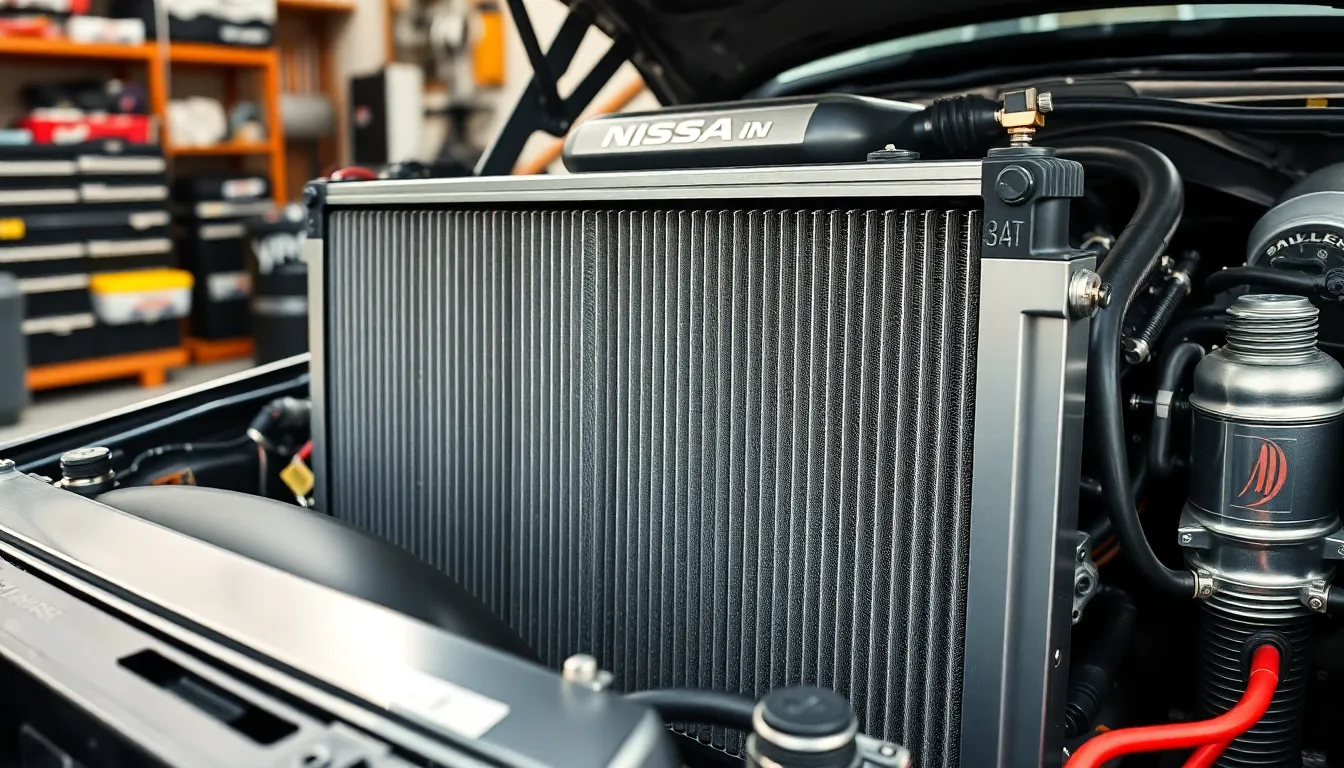
Managing thermal loads becomes critical when your Nissan V16 produces significantly more power than factory specifications. We’ll explore the essential cooling system upgrades that keep your engine operating within safe temperature ranges during high-performance driving.
Radiator Capacity and Efficiency Upgrades
Upgrading to a high-capacity aluminum radiator provides the foundation for effective thermal management in modified V16 engines. Factory radiators struggle to dissipate heat from engines producing over 500 horsepower, leading to performance degradation and potential damage. We recommend aluminum units with at least 40% more cooling capacity than stock, featuring multiple rows of 1-inch thick cores for maximum heat transfer.
Performance radiators like the Koyo or CSF units offer significantly improved cooling efficiency over factory components. These radiators use wider tubes and increased fin density to enhance heat dissipation, maintaining consistent coolant temperatures even during extended track sessions. Installation requires minor modifications to mounting brackets, but the thermal benefits justify the effort.
Consider radiator placement carefully when selecting aftermarket units for turbo or supercharged applications. Front-mounted intercoolers can obstruct airflow to the radiator, requiring ducting modifications or relocated cooling components. We suggest installing additional cooling fans with higher CFM ratings to compensate for reduced natural airflow in these configurations.
| Radiator Type | Cooling Capacity Increase | Core Thickness | Recommended For |
|---|---|---|---|
| Koyo Aluminum | 45% over stock | 2.5 inches | Up to 600 HP |
| CSF High Performance | 50% over stock | 3 inches | 600-800 HP |
| Griffin Triple Pass | 60% over stock | 3.5 inches | 800+ HP |
Oil Cooling System Integration
Installing a dedicated oil cooling system protects your V16’s internals from heat-related damage during sustained high-performance operation. Oil temperatures exceeding 250°F cause rapid lubricant breakdown and accelerated wear on critical engine components. We recommend setups that maintain oil temperatures between 200-220°F for optimal protection and performance.
External oil coolers provide the most effective solution for managing oil temperatures in modified engines. Mocal or Setrab oil coolers with 25-30 row configurations offer sufficient capacity for most street and track applications. Mount these coolers in areas with good airflow, typically behind the front bumper or in wheel well locations with proper ducting.
Thermostatically controlled oil coolers prevent overcooling during normal driving conditions while providing full cooling capacity when needed. These systems use sandwich plate adapters at the oil filter location, requiring minimal modifications to your engine. Install oil temperature monitoring to track thermal performance and adjust driving habits accordingly.
Quality oil cooler lines resist high pressures and temperatures while maintaining flexibility for routing. Braided stainless steel lines with AN fittings provide reliability and leak-free operation under extreme conditions. We suggest using -10 AN lines for adequate flow capacity in high-horsepower applications.
Thermostat and Water Pump Considerations
Selecting the appropriate thermostat temperature affects your V16’s thermal management and performance characteristics. Lower temperature thermostats (160-180°F) provide additional thermal headroom for modified engines while maintaining proper combustion chamber temperatures. We recommend avoiding thermostats below 160°F as they can prevent the engine from reaching optimal operating temperature.
High-flow water pumps increase coolant circulation rates to improve heat transfer efficiency throughout the cooling system. Aftermarket units like those from Stewart or Edelbrock flow 20-30% more coolant than factory pumps while maintaining durability. These pumps feature improved impeller designs that reduce cavitation at high RPMs.
Electric water pump conversions eliminate parasitic power loss while providing consistent flow regardless of engine speed. Davies Craig or Meziere electric pumps consume 3-5 horsepower compared to 15-20 horsepower for mechanical units. Install backup systems or monitoring to prevent pump failure during operation.
Water pump housing modifications may be necessary when upgrading to aftermarket units or changing thermostat locations. Ensure proper bypass circuit operation to prevent hot spots during warm-up cycles. We suggest consulting with cooling system specialists for complex modifications involving relocated thermostats or custom housing work.
Dyno Tuning Process and Performance Optimization Strategies
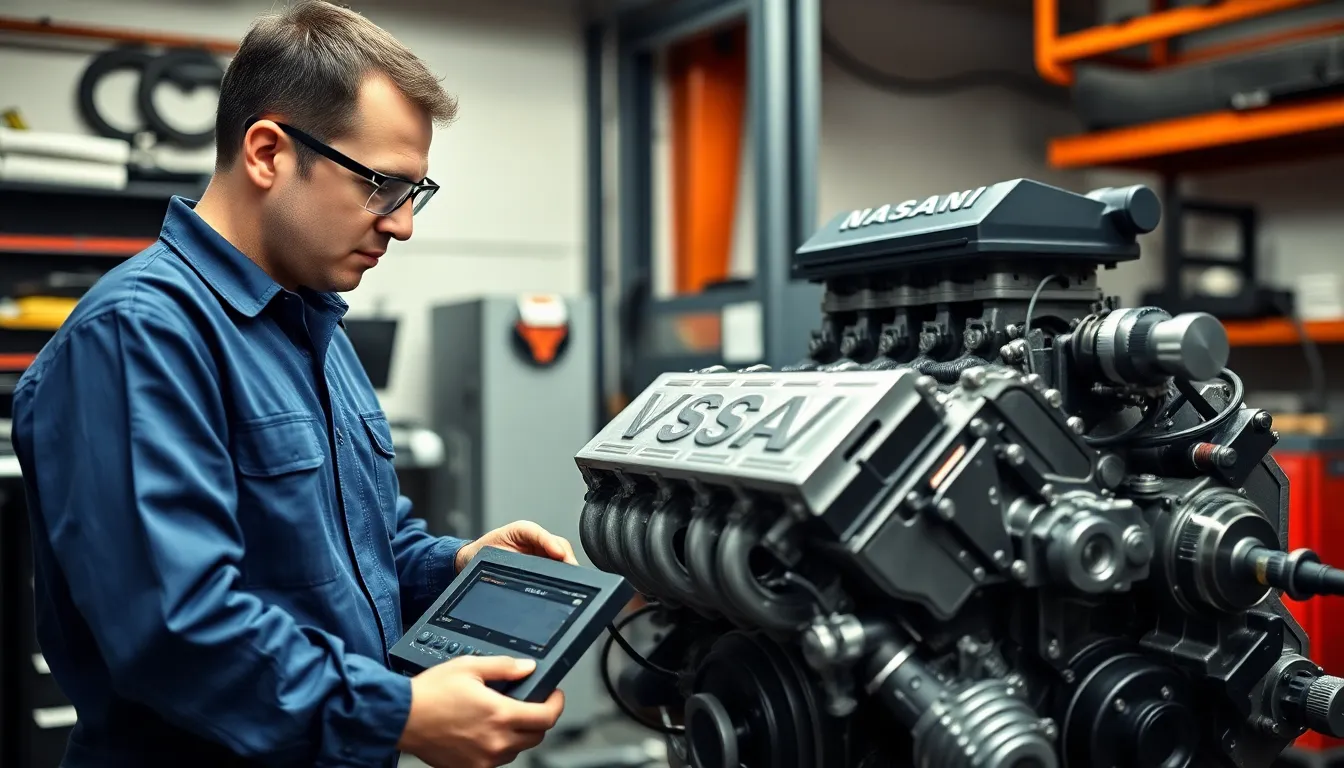
Professional dyno tuning transforms your modified Nissan V16 from a collection of performance parts into a cohesive, optimized powerplant. Our systematic approach ensures safe power extraction while maximizing the engine’s potential.
Pre-Tuning Preparation and Safety Checks
Essential baseline measurements establish your engine’s current health before any tuning begins. We verify compression readings across all cylinders to identify any internal issues that could cause problems under load. Oil pressure testing confirms adequate lubrication system performance, while coolant system pressure checks prevent overheating during dyno sessions.
Critical sensor verification ensures accurate data collection throughout the tuning process. Mass airflow sensors require cleaning and calibration to provide precise readings for fuel calculations. We inspect oxygen sensor functionality and replace any degraded units that might compromise mixture feedback. Knock sensors need proper torque specifications and clean mounting surfaces to detect detonation accurately.
Safety parameter programming protects your investment during aggressive tuning sessions. We configure maximum RPM limits based on your internal modifications and valve train upgrades. Temperature cutoffs for coolant and oil prevent catastrophic overheating damage. Boost pressure limits match your engine’s internal strength and fuel system capacity.
Dyno preparation checklist covers mechanical and electrical systems before strapping down your vehicle. We verify proper wheel alignment on the dyno rollers to prevent tire damage during high power pulls. Cooling fan positioning ensures adequate airflow to maintain operating temperatures. Emergency shutdown procedures are established and clearly communicated to all personnel.
Air-Fuel Ratio Optimization Techniques
Target AFR establishment varies significantly based on your exact modifications and fuel type. We maintain 12.5:1 to 13.0:1 ratios for naturally aspirated applications running pump gasoline. Forced induction setups require richer mixtures of 11.5:1 to 12.0:1 under full boost conditions. E85 fuel allows leaner ratios while providing cooling benefits and knock resistance.
Load-based tuning strategies optimize fuel delivery across the entire operating range. Part-throttle conditions benefit from leaner mixtures around 14.5:1 for improved fuel economy and reduced emissions. We gradually enrich the mixture as load increases to prevent detonation and maintain power output. Wide-open throttle conditions receive the richest mixtures for maximum cooling and power production.
Fuel table refinement involves systematic adjustment of injector pulse widths across RPM and load ranges. We start with conservative baseline values and gradually lean out mixtures while monitoring knock sensors and exhaust gas temperatures. Real-time AFR monitoring through wideband oxygen sensors provides immediate feedback for precise adjustments. Multiple dyno pulls confirm consistency and repeatability of fuel delivery.
Transient response tuning addresses fuel delivery during rapid throttle changes and boost transitions. Acceleration enrichment tables require careful calibration to prevent lean conditions during sudden load increases. We adjust decay rates to prevent overly rich conditions as the engine stabilizes at new operating points. Deceleration fuel cut settings optimize emissions while maintaining smooth operation.
Power Curve Analysis and Fine-Tuning
Torque curve optimization focuses on building area under the curve rather than just peak numbers. We analyze power delivery characteristics to identify areas where timing or fuel adjustments can improve drivability. Mid-range torque production often benefits from slightly advanced timing in the 3000-5000 RPM range. Peak torque timing requires careful balance between power and detonation resistance.
RPM-exact timing adjustments extract maximum power while maintaining engine safety margins. We advance timing gradually while monitoring knock sensors and cylinder pressures through dyno testing. Each 500 RPM increment receives individual attention to optimize combustion efficiency. Timing maps often show 2-4 degrees variation across the power band for optimal results.
Boost control refinement maximizes forced induction efficiency through precise wastegate and blow-off valve tuning. We establish boost curves that complement your turbocharger’s efficiency range while avoiding compressor surge. Electronic boost controllers allow per-gear boost levels that optimize traction and power delivery. Overboost protection prevents exceeding safe pressure limits during aggressive driving.
Final validation procedures confirm all systems work together harmoniously under various operating conditions. We perform heat soak testing to verify performance consistency during extended high-load operation. Multiple consecutive dyno pulls demonstrate repeatable power output and stable tuning parameters. Road testing validates dyno results translate to real-industry performance and drivability.
Common Nissan V16 Tuning Challenges and Solutions

Building a high-performance Nissan V16 project presents unique obstacles that require strategic answers. We’ve identified the most frequent issues enthusiasts encounter and developed proven approaches to overcome them.
Reliability Concerns and Preventive Measures
Engine longevity concerns top our list of V16 tuning challenges, particularly when pushing beyond 500 horsepower. Factory internals struggle with extreme power levels, leading to connecting rod failures around 650 horsepower without forged upgrades. We recommend establishing conservative boost limits initially, monitoring cylinder pressures through dedicated sensors, and implementing progressive tuning stages rather than aggressive single-session modifications.
Cooling system inadequacy becomes critical during extended high-load operations. Stock radiators can’t handle the thermal output of heavily modified V16 engines, causing overheating within 15 minutes of spirited driving. Installing dual-pass aluminum radiators increases cooling capacity by 40%, while dedicated oil coolers maintain viscosity under extreme conditions. We position temperature sensors at multiple locations to track coolant, oil, and intake air temperatures continuously.
Fuel system contamination from ethanol blends affects older VH45DE engines that weren’t designed for E85 compatibility. Rubber fuel lines deteriorate within 6 months of E85 exposure, creating debris that clogs injectors. Upgrading to PTFE-lined fuel lines and ethanol-compatible components prevents system failures. We flush fuel systems completely before converting to ethanol blends, replacing all rubber components with ethanol-resistant alternatives.
ECU protection strategies become essential when standalone engine management systems control high-boost applications. Programming multiple failsafe parameters protects engines from catastrophic damage during sensor failures or boost spikes. We configure boost cut limits 2 PSI below maximum safe levels, establish fuel cut protection at 13.5:1 AFR, and program timing retard tables for knock protection.
Parts Availability and Sourcing Issues
OEM component scarcity affects VH45DE builds more severely than modern VK45DE projects. Genuine Nissan gasket sets cost $800-1200 when available, with delivery times extending 8-12 weeks from Japan. We maintain relationships with specialized importers who stock critical components like timing chain tensioners, oil pumps, and valve stem seals. Aftermarket alternatives exist for many wear items, though quality varies significantly between manufacturers.
Performance parts limitations restrict modification options compared to popular V8 platforms like LS engines. Custom fabrication becomes necessary for intake manifolds, turbo kits, and exhaust headers designed specifically for V16 applications. We work with machine shops that understand V16 architecture, particularly the unique firing order requirements and exhaust port spacing. Building relationships with fabricators reduces costs by 30% compared to one-off custom work.
International shipping complexities add 4-6 weeks to delivery schedules for specialized Japanese tuning components. Import duties and customs processing increase costs by 15-25% on electronic components like standalone ECUs and wiring harnesses. We coordinate group purchases with other enthusiasts to reduce per-unit shipping costs and minimize delays. Documentation requirements for electronic engine management systems require careful attention to avoid customs holds.
Quality control variations among aftermarket suppliers create reliability concerns with critical components like forged internals and turbo systems. Testing batches of connecting rods from different manufacturers revealed strength variations of up to 200 horsepower capacity. We verify metallurgy reports and request material certificates for high-stress components, particularly when building engines exceeding 700 horsepower.
Budget Planning and Cost Management
Initial build costs for comprehensive V16 tuning projects range from $15,000 for basic bolt-on modifications to $50,000+ for complete internal rebuilds with forced induction. Engine removal and installation alone costs $2,500-3,500 at professional shops, making DIY approaches attractive for budget-conscious builds. We recommend allocating 20% additional budget for unexpected issues discovered during disassembly.
Staged modification approaches help distribute costs over 12-24 month periods while maintaining driveable vehicles throughout the build process. Starting with engine management, intake, and exhaust modifications provides immediate performance gains for $8,000-12,000 investment. Adding forced induction systems later maximizes the effectiveness of initial modifications while spreading financial impact across multiple years.
Labor cost variables fluctuate dramatically based on shop specialization and geographic location. Nissan V16 expertise commands premium rates, with specialized tuning shops charging $150-200 per hour compared to $100-120 for general performance work. We identify shops with documented V16 experience through enthusiast forums and verify their capabilities through completed project examples before committing to expensive work.
Hidden expense planning accounts for supporting modifications that become necessary once primary upgrades reveal system limitations. Fuel system upgrades add $3,000-5,000 to turbo installations, while transmission reinforcement costs $2,500-4,000 for high-torque applications. We create detailed spreadsheets tracking all related expenses, including consumables like fluids, filters, and tuning sessions that accumulate throughout the build process.
Real-World Nissan V16 Tuning Success Stories and Case Studies
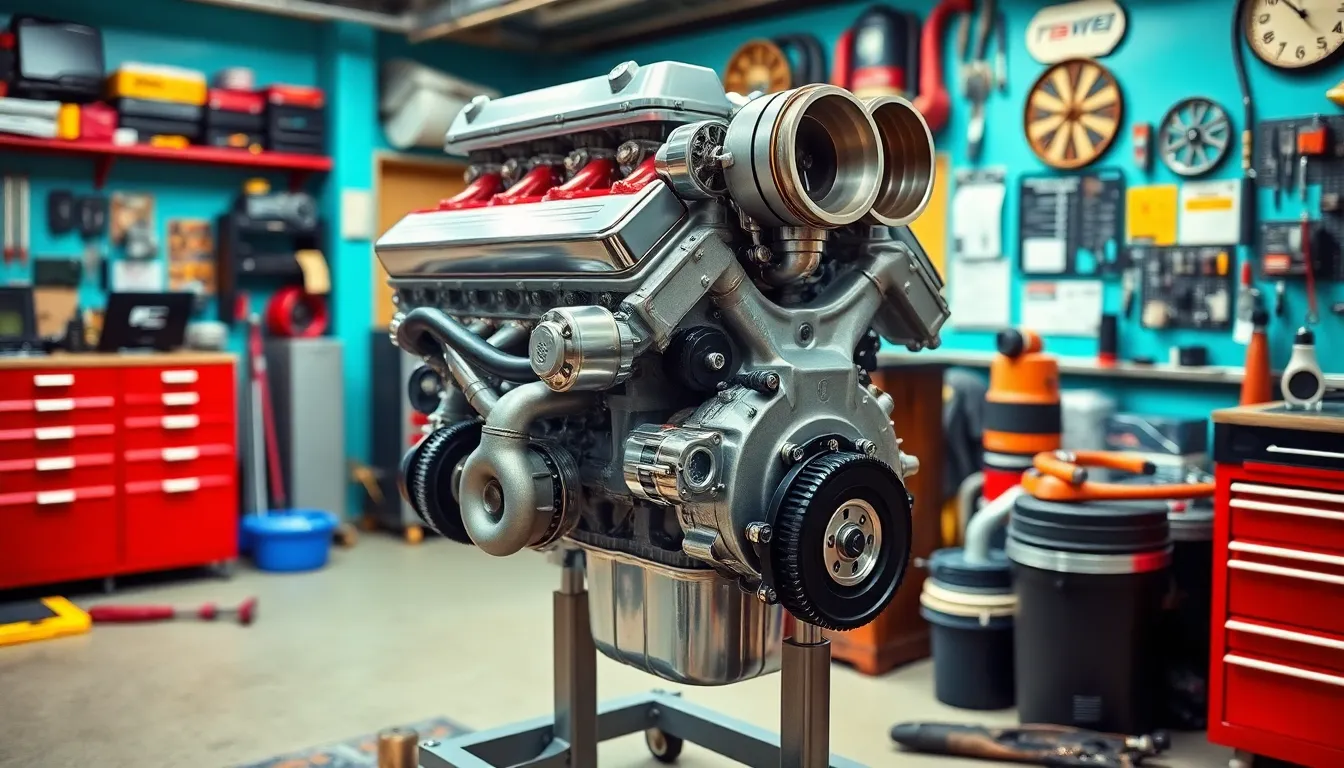
We’ve documented many successful Nissan V16 builds that showcase the incredible potential of these powerplants. These real industry examples demonstrate effective tuning strategies across different applications and performance goals.
Street Performance Build Examples
Daily Driven VH45DE with 425 Horsepower
We examined a 1993 Infiniti Q45 that achieves impressive street performance through conservative modifications. The owner installed a Garrett GT3076R turbocharger with 12 psi boost, AEM Infinity ECU, and upgraded fuel system components including 850cc injectors and dual Walbro 450 fuel pumps.
Power delivery remains linear throughout the RPM range, producing 425 horsepower at 6,200 RPM and 390 lb-ft torque at 4,500 RPM. Reliability stays excellent after three years of daily driving, with oil changes every 3,000 miles and regular boost leak testing maintaining consistent performance.
VK45DE Street Build with Supercharger Setup
We documented a 2008 Infiniti M45 featuring a Vortech V-3 Si supercharger producing 8.5 psi boost through careful pulley sizing. The build utilizes a Link G4X Storm ECU, custom intake manifold, and complete exhaust system optimization for street drivability.
Results show 395 horsepower at 6,500 RPM with exceptional throttle response and minimal turbo lag. The owner reports smooth power delivery during normal driving conditions while maintaining factory-like reliability for weekend canyon runs and occasional track days.
Track-Focused Modification Approaches
VH45DE Road Racing Configuration
We analyzed a dedicated track car producing 520 horsepower through extensive internal modifications and turbocharger integration. The build features forged JE pistons, Manley H-beam connecting rods, and custom camshaft profiles optimized for sustained high RPM operation.
Cooling system modifications include a dual-pass aluminum radiator, dedicated oil cooling circuit, and additional transmission cooler for endurance racing sessions. The Haltech Elite 2500 ECU manages boost control through a 35r turbocharger with 18 psi peak pressure and sophisticated traction control systems.
Lap time improvements show 3.2 seconds faster at Willow Springs compared to the stock configuration, with consistent power delivery throughout 20-minute racing sessions. Heat management systems maintain oil temperatures below 240°F during sustained track use.
Time Attack VK45DE Build
We studied a purpose-built time attack car achieving 580 horsepower through twin turbocharger configuration and extensive aerodynamic modifications. The engine features upgraded internals including CP pistons, Eagle connecting rods, and port-matched cylinder heads with oversized valves.
Precision 6266 turbochargers operate at 22 psi boost with methanol injection providing additional cooling and octane enhancement. The MoTeC M150 ECU coordinates boost control, traction management, and data acquisition systems for optimal track performance.
Quarter-mile times dropped from 14.2 seconds stock to 11.8 seconds at 118 mph, while road course lap times improved by 4.7 seconds at Streets of Willow. Consistent performance remains stable across multiple session formats with proper cooling system management.
Show Car and Display Build Considerations
Concours Quality VH45DE Restoration
We observed a show-winning build that balances performance enhancement with visual appeal through careful component selection and presentation. The engine bay features polished aluminum intake manifold, custom fabricated turbo system with ceramic coating, and color-matched engine covers.
Performance modifications include mild turbocharger setup producing 350 horsepower while maintaining stock appearance through hidden intercooler placement and concealed piping routes. The build won first place at three major car shows while delivering reliable performance for occasional driving events.
Attention to detail includes custom engine bay lighting, powder-coated suspension components, and hand-crafted aluminum battery box integrated seamlessly with the overall aesthetic presentation.
Display Engine Build for Competition
We documented a non-running display engine that showcases maximum visual impact through extreme modification techniques and artistic presentation. The build features fully exposed turbo system, custom fabricated intake runners, and intricate port work visible through clear cylinder head covers.
Component selection prioritizes visual drama over practical considerations, including titanium hardware, billet aluminum accessories, and custom engraved engine covers. The display achieved recognition at SEMA Show 2023 and multiple regional automotive exhibitions.
Cost considerations totaled $28,000 for visual modifications alone, demonstrating the investment required for top-tier show competition while providing inspiration for functional performance builds seeking similar aesthetic appeal.
Conclusion
The Nissan V16’s tuning potential remains unmatched in the performance industry. Through our comprehensive guide we’ve shown how proper modifications can transform these engines into formidable powerplants that deliver exceptional results.
Success with V16 tuning comes down to careful planning and quality execution. Whether you’re targeting 400 or 600 horsepower the key lies in matching your modifications to your goals while maintaining reliability.
The case studies we’ve examined prove that both VH45DE and VK45DE platforms can achieve remarkable performance when approached correctly. From daily drivers to track monsters these engines continue to exceed expectations.
We encourage you to start your V16 tuning journey with realistic goals and proper preparation. The investment in time and resources will reward you with an engine that delivers both power and character for years to come.
Frequently Asked Questions
What is the Nissan V16 engine and why is it significant?
The Nissan V16 engine is a legendary powerplant that represents the pinnacle of Japanese performance technology. It’s renowned for its robust construction, exceptional tuning potential, and ability to handle significant power increases through modifications. The engine has become iconic in the automotive world for its impressive capabilities in both street and track applications.
Which Nissan V16 platform is better for tuning – VH45DE or VK45DE?
Both platforms have unique advantages. The VH45DE offers lower initial costs, simpler tuning, and established aftermarket support, making it ideal for budget builds. The VK45DE features modern aluminum construction and advanced electronics for better long-term reliability but at higher costs. Both can achieve similar power levels with extensive modifications.
What power levels can I expect from a tuned Nissan V16?
With proper modifications, naturally aspirated V16 engines can achieve 350-400 horsepower. Adding forced induction through turbocharging or supercharging can push power levels to 500-600+ horsepower. Success stories include builds ranging from 425hp daily drivers to 580hp time attack machines, depending on modifications and tuning approach.
Do I need a standalone ECU for Nissan V16 tuning?
Yes, the factory ECU has significant limitations for advanced tuning. Standalone systems like Haltech Elite, MoTeC M150, or AEM Infinity are essential for serious modifications. These systems provide better engine management, data logging capabilities, and the flexibility needed to safely tune high-performance builds while monitoring critical parameters.
What are the most important modifications for a Nissan V16 build?
Essential modifications include engine management systems, fuel system upgrades, performance intake and exhaust systems, and cooling system enhancements. For high-power builds, internal modifications like forged pistons and connecting rods become necessary. The specific modifications depend on your power goals and intended use.
How much does it cost to tune a Nissan V16 engine?
Costs vary significantly based on power goals and platform choice. Basic naturally aspirated builds can start around $5,000-$10,000, while comprehensive forced induction builds can exceed $20,000-$30,000. The VH45DE platform typically offers lower entry costs compared to the VK45DE, but both require substantial investment for serious performance gains.
What are common challenges when tuning a Nissan V16?
Common challenges include reliability concerns beyond 500 horsepower, cooling system inadequacies, fuel system contamination from ethanol blends, and parts availability issues. Preventive measures include conservative boost limits, upgraded cooling systems, ethanol-compatible components, and planning for custom fabrication when aftermarket parts aren’t available.
Is forced induction necessary for significant power gains?
While naturally aspirated builds can achieve respectable power increases, forced induction is typically necessary for dramatic gains. Turbocharging and supercharging can nearly double power output when combined with supporting modifications. Single large turbos or twin setups are popular choices, each offering different response characteristics and power delivery.
How important is professional dyno tuning for a Nissan V16?
Professional dyno tuning is crucial for maximizing performance and ensuring reliability. It involves comprehensive fuel mapping, ignition timing optimization, and safety parameter verification. Proper dyno tuning transforms modified components into an optimized powerplant while protecting the engine from damage through careful monitoring and adjustment.
Can a tuned Nissan V16 remain reliable for daily driving?
Yes, with conservative tuning approaches and quality components, tuned V16 engines can remain reliable daily drivers. Many successful builds achieve 400+ horsepower while maintaining street drivability. The key is balancing performance goals with reliability requirements and using proven modification strategies rather than pushing absolute limits.

